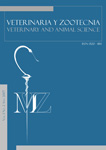Authors
Abstract
ABSTRACT: This study was designed to evaluate the effect of Se supplementation on the superovulatory response and embryo recovery in dairy lactating bovines treated with eCG. Twenty—three Black Friesian lactating cows were selected, from which heparinized blood was taken 20 days prior to the superovulatory treatment in order to determine the blood activity of GSH-Px. The control group (n=11) received 5 ml i.m. of distilled water, and the treated group (n=12) received 5 mg Se/100 kpw i.m. The superovulatory treatment was given between the 9th and 11th day after the estrous cycle, with each cow receiving 2500 UI i.m. of eCG. Prior to insemination, the cows were injected with 750 µg i.m. of tiaprost, and inseminated twice after 48 hours. The ovarian response was evaluated by ultrasonography, and the embryos were recovered by a non-surgical method. The results were analyzed by a “t” test. The use of Se did not produce significant changes on the GSH-Px activity (P>0.05). The number of follicles found in the treated group was higher than in the control group (P<0.05); however, the number of corpus luteum, ova–embryos and freezable embryos was similar in both groups (P>0.05). The recovery rate of ova– embryo was 63% and 59% for the control and treated group, and the rate of freezable embryos was 33% and 61% for the control group and treated group, respectively. Accordingly, the use of Se in lactating dairy bovines increased the number of follicles, but it did not affect the rate of ovulations and embryo recovery.
References
Ceballos, A.; Wittwer, F. Metabolismo del selenio en rumiantes. Arch. Med. Vet, v.28, p.5-18, 1996.
Ceballos, A.; Wittwer, F.; Contreras, P.A. et al. Actividad sanguínea de glutatión peroxidasa en rebaños lecheros a pastoreo: variación según edad y época del año. Arch. Med. Vet. v.30, (en prensa), 1998.
Fujitani, Y.; Kasai, K.; Ohtani, S. et al. Effects of oxygen tension, free radicals, and hypotaurine on development of in vitro-derived bovine embryos. Theriogenology, v.45, p.210, 1996.
Gutteridge, J.M.C.; Halliwell, B. Antioxidants in nutrition, health, and disease. Oxford: Oxford University Press, 1994.
Jain, N.C. Schalm´s Veterinary hematology. 4th.ed.
Philadelphia: Lea & Febiger, 1986.
Kamada, H.; Ikumo, H. Effect of selenium on cultured bovine luteal cells. Anim. Repr. Sci, v.46, p.203- 211, 1997.
Mapletoft, R.J.; Pierson, R.A. Factors affecting superovulation in the cow: practical considerations. En: Delcampo, C.H., Patiño, M.; Del Campo, M. Relaciones embrio-maternas y biotecnologías reproductivas. Valdivia: Universidad Austral de Chile, 1995. p.36-58.
Mapletoft, R.J.; Bo, G.; Alkewade, S.J. The effect of biological activity of gonadotrophins on superovulation in the cow. En: Del Campo, C.H.; Patiño, M.; Del Campo, M. Relaciones embrio-maternas y biotecnologías reproductivas. Valdivia: Universidad Austral de Chile, 1995. p.16-35.
Miller, J.K.; Brzezinska-Slebodzinska, E.; Madsen, F.C. Oxidative stress, antioxidants, and animal function. J. Dairy Sci, v.76, p.2812-2823, 1993.
Monniaux,D.;Chupin,D.;Saumande,J.Superovulatory responses of cattle. Theriogenology, v.19, p.55- 81, 1983.
National Research Council. Selenium in nutrition. Rev. Ed., National Academy Press. Washington, D.C. 1983.
Oblitas, F.; Wittwer, F.; Contreras P.A. et al. Efecto de la suplementación con selenio en la actividad sanguínea de glutatión peroxidasa (GSH-Px) y ganancia de peso de vaquillas. En: XXI Reunión anual de la Sociedad Chilena de Producción Animal. Coyhaique. p.143-144, 1996.
Paglia, D.E.; Valentine, W.N. Studies on the quantitative and qualitative characterisation of erythrocyte gluthatione peroxidase. J. Lab. and Clin. Med, v.70, p.158-169, 1967.
Pearson, E.S.; Stephens M.A. The ratio of range to standard deviation in the same normal sample. Biometrika, v.51, p.484-487, 1964.
Segerson, E.C.; Murray, F.A.; Moxon, A.L. et al. Selenium/vitamin E: role in fertilization of bovine ova. J. Dairy Sci., v.60, p.1001-1005, 1977.
Segerson, E.C.; Riviere, R.; Bullock, T.R. et al. Uterine contractions and electrical activity in ewes treated with selenium and vitamin E. Biol. Repr., v.23, p.1020-1028, 1980.
Segerson, E.C.; Libby, D.W. Ova fertilization and sperm number per fertilized ovum for selenium and vitamin E-treated Charolais cattle. Theriogenology., v.17, p.333-341, 1982.
Wichtel, J.J.; Craigie,A.L.;Thompson, K.G. etal. Effect of selenium and A-tocopherol supplementation on postpartum reproductive function of dairy heifers at pasture. Theriogenology, v.46, p.491-502, 1996.
Wittwer, F. Antecedentes del balance nutricional de selenio en Chile y su suplementación en el ganado. En: Wittwer, F.; Ceballos, A. Estrés oxidativo y antioxidantes en la salud y nutrición animal. Valdivia: Universidad Austral de Chile, 1997. p.27-35.
Zar, J.H. Biostatistical analysis. 3.ed. Upper Saddle River, USA: Prentice Hall, 1996.

 PDF (Español)
PDF (Español)
 FLIP
FLIP










